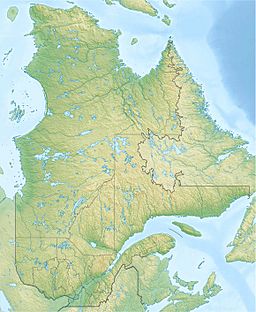Lake Manouane (Mont-Valin) facts for kids
Quick facts for kids Lake Péribonca |
|
|---|---|
| Location | Mont-Valin, Le Fjord-du-Saguenay Regional County Municipality, Quebec |
| Coordinates | 50°42′18″N 70°44′57″W / 50.70500°N 70.74917°W |
| Primary inflows | Petite rivière des Perdrix Blanches, rivière des Montagnes Blanches |
| Primary outflows | Manouane River (Péribonka River) and Bonnard River |
| Basin countries | Canada |
| Max. length | 54 kilometres (34 mi) |
| Max. width | 33 kilometres (21 mi) |
| Surface area | 461 kilometres (286 mi) |
| Surface elevation | 490 kilometres (300 mi) |
Lake Péribonca is a large freshwater lake located in the unorganized territory of Mont-Valin, Quebec, Canada. It's part of the Le Fjord-du-Saguenay Regional County Municipality in the Saguenay-Lac-Saint-Jean region of Quebec.
This big lake is usually frozen from mid-November until the end of April. However, it's safest to travel on the ice from mid-December to the end of March. In the past, the area around the lake was important for logging. Today, people also enjoy visiting for fun activities and for the power generated by hydroelectricity.
Contents
Exploring Lake Péribonca's Geography
Lake Péribonca is found in a forest area, about 250 kilometers (155 miles) northeast of Lac Saint-Jean. It covers a huge area of 461 square kilometers (178 square miles).
The Lake's Unique Shape
The lake has a very interesting and complex shape. Its shores stretch for over 420 kilometers (260 miles) and form many peninsulas, which are pieces of land almost surrounded by water. The lake also has many wide and deep bays, like Mauves Bay and Foxes Bay. One bay, "Mica" Bay, got its name because the mineral mica was found there. You'll also find many islands scattered across the lake.
Rivers Flowing In and Out
Several streams and rivers feed into Lake Péribonca. One important river that flows into it is the rivière des Montagnes Blanches.
Lake Péribonca then empties into the Manouane River. This river is one of the main branches of the Péribonka River. The Manouane River flows through several other lakes, including Opitouane Lake. Another river, the Bonnard River, also flows out of Lake Péribonca.
How Dams Changed the Lake
Between 1940 and 1941, dams were built at the outlet of Lake Péribonca. These dams caused the water level to rise, making the lake 25% larger! Other dams were also built further upstream. One of these dams, made entirely of wood, is over 500 meters (1,640 feet) long, making it the longest of its kind in Quebec.
These dams help control the water supply for hydroelectric power plants located downstream on the Péribonka River. This means the dams help make electricity for people to use.
Lake Péribonca's Water Journey
From the mouth of Lake Péribonca, the water flows south into the Manouane River. Then, it joins the Péribonka River and continues south. The water then crosses Lac Saint-Jean to the east. Finally, it flows along the Saguenay River all the way to Tadoussac, where it meets the mighty St. Lawrence River.
The Name of Lake Péribonca
The name "Lake Manouane" was officially recognized in 1945. However, this name appeared on maps as early as 1705, spelled as "Manouan." Over time, it has also been spelled "Manuan" and "Manowan."
The name comes from the Montagnais language, an Indigenous language. "Manauan Shakaika" means "lake where we collect eggs." This term likely comes from "manneu," which means "to remove by hand," and "uau," meaning "egg." The Montagnais people used to collect bird eggs from the islands and shores of this lake.
The official name Lake Manouane was set on December 5, 1968, by the Commission de toponymie du Québec, which is like a naming committee for places in Quebec.


